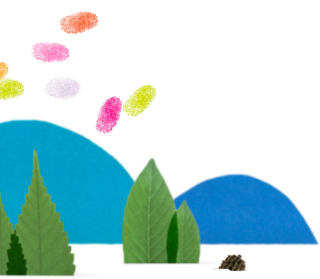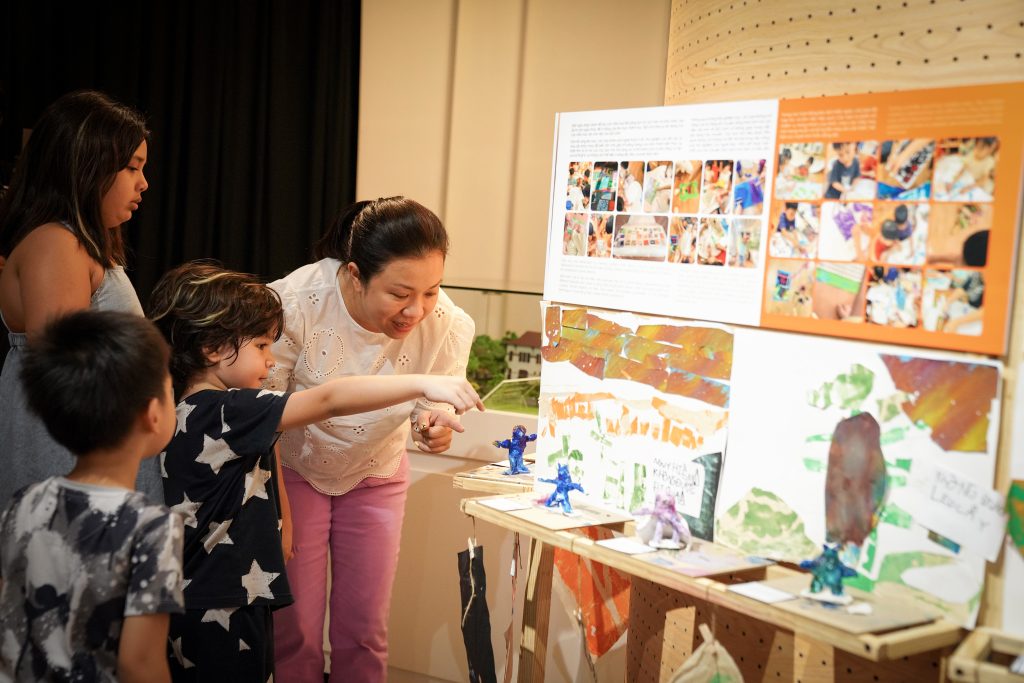
The Reggio Emilia Approach®️ – an inquiry-based learning approach – values the belief that children are strong, competent, and capable citizens full of wonder and curiosity to learn. It believes that children have a natural drive that makes them want to understand and know about the world around them and how this world relates to them. Every child brings with them deep curiosity and potential, and this innate curiosity drives their interest in understanding their world and their place within it. Children are believed to be capable of constructing their research methods and learning using everything from play to various hands-on learning experiences.
To understand the Reggio Emilia Approach®️, let’s visit the fundamental principles of this approach:
1. ALL CHILDREN ARE COMPETENT, CURIOUS AND CREATIVE

At the very core of the Reggio Emilia Approach®️ is the concept of wonder. Wonder is an act that begins the process of learning, and wonder is an integral quality within all children. Reggio educators view children as natural scientists driven by curiosity, tremendous observational skills, and the ability to form robust theories about the world around them. They consider a child’s creative expression (especially in preliterate stages) to communicate what they understand about the world around them.
2. ESSENTIAL LEARNING TAKES PLACE WITHIN A SYSTEM OF RELATIONSHIPS

Reggio teachers believe that when children share their wonder with other children, their parents or teachers, they engage in a more prosperous and profound learning process. Collaboration increases the children’s commitment to the topic and multiplies the learning opportunities by encompassing many points of view. In school, when this type of ‘group wonder’ is guided by teachers who use provocations and questioning rather than demonstrations or explanations, children will almost always be able to connect to the topic.
We will focus on creating a collaborative community and a learning environment where children are at the center of the classroom and teachers are seen as co-constructors, researchers, documenters, and advocates for the children.
3. CHILDREN’S QUESTIONS AND INTERESTS ARE A FOUNDATION FOR LEARNING EXPERIENCES

Collaborative wonder and sharing ideas plant the seeds for the emergent curriculum. For example, during the first full-group discussion of the sky, a classmate might share her knowledge of planets or the moon (leading to a study of planets and stars). At the same time, another child might want to work on making a picture book about cloud animals (an opportunity for art and literacy development). It’s important to note that a teacher would never intervene in a discussion with children to ‘weed out the truth from fiction’ or give answers. Instead, the teacher would extend and compile the ideas to be presented to the group for theory development. In this way, teachers guide children as they build their knowledge and ‘image.’
4. CHILDREN EXPRESS THEMSELVES THROUGH THE “HUNDRED LANGUAGES”

In traditional schools, children are often judged by their success using verbal and written forms of expression above all others, in part because test-taking depends on these skills. At Little Em’s, all forms of expression are valued equally and fundamental in holistically developing children.
5. DOCUMENTATION ALLOWS CHILDREN AND ADULTS TO REMEMBER AND REFLECT ON LEARNING EXPERIENCES

Teachers document the children’s experience through photographs, note-taking, video, and various art forms throughout the learning process. It is compiled and shared with a focus on process rather than product.
In using this approach to education, time is given to the children so they may be allowed to learn, explore, or go back and revisit an investigation or a focus of interest as needed. It is an approach based on listening rather than talking, where doubt and amazement are welcome factors, scientific inquiry, and deductive methods used by detectives.
We keep in mind that all children are equal learners; we let them learn through their mistakes rather than correcting them. Unlike other programs, where teachers are required to take note of students’ development through ‘Assessment Reports’, evidence of learning is documented using written, photographic and video records throughout the year. This allows children, parents and teachers to realize growth, facilitate conversations and plan for future learning.
Although the Reggio Emilia Approach®️ is applied to preschools and early childhood settings, as parents grow in their understanding of the general principles, this inspiring child-led approach can also be adapted to the home. Therefore, pursuing this approach in the early years also helps parents to be more involved in their children’s education and childhood.
CURRICULUM
To understand the Reggio Emilia Approach®️, let’s visit the fundamental principles of this approach:
1. ALL CHILDREN ARE COMPETENT, CURIOUS AND CREATIVE
At the very core of the Reggio Emilia Approach®️ is the concept of wonder. Wonder is an act that begins the process of learning, and wonder is an integral quality within all children. Reggio educators view children as natural scientists driven by curiosity, tremendous observational skills, and the ability to form robust theories about the world around them. They consider a child’s creative expression (especially in preliterate stages) to communicate what they understand about the world around them.
2. ESSENTIAL LEARNING TAKES PLACE WITHIN A SYSTEM OF RELATIONSHIPS
Reggio teachers believe that when children share their wonder with other children, their parents or teachers, they engage in a more prosperous and profound learning process. Collaboration increases the children’s commitment to the topic and multiplies the learning opportunities by encompassing many points of view. In school, when this type of ‘group wonder’ is guided by teachers who use provocations and questioning rather than demonstrations or explanations, children will almost always be able to connect to the topic.
We will focus on creating a collaborative community and a learning environment where children are at the center of the classroom and teachers are seen as co-constructors, researchers, documenters, and advocates for the children.
3. CHILDREN’S QUESTIONS AND INTERESTS ARE A FOUNDATION FOR LEARNING EXPERIENCES
Collaborative wonder and sharing ideas plant the seeds for the emergent curriculum. For example, during the first full-group discussion of the sky, a classmate might share her knowledge of planets or the moon (leading to a study of planets and stars). At the same time, another child might want to work on making a picture book about cloud animals (an opportunity for art and literacy development). It’s important to note that a teacher would never intervene in a discussion with children to ‘weed out the truth from fiction’ or give answers. Instead, the teacher would extend and compile the ideas to be presented to the group for theory development. In this way, teachers guide children as they build their knowledge and ‘image.’
4. CHILDREN EXPRESS THEMSELVES THROUGH THE “HUNDRED LANGUAGES”
In traditional schools, children are often judged by their success using verbal and written forms of expression above all others, in part because test-taking depends on these skills. At Little Em’s, all forms of expression are valued equally and fundamental in holistically developing children.
5. DOCUMENTATION ALLOWS CHILDREN AND ADULTS TO REMEMBER AND REFLECT ON LEARNING EXPERIENCES
Teachers document the children’s experience through photographs, note-taking, video, and various art forms throughout the learning process. It is compiled and shared with a focus on process rather than product.
In using this approach to education, time is given to the children so they may be allowed to learn, explore, or go back and revisit an investigation or a focus of interest as needed. It is an approach based on listening rather than talking, where doubt and amazement are welcome factors, scientific inquiry, and deductive methods used by detectives.
We keep in mind that all children are equal learners; we let them learn through their mistakes rather than correcting them. Unlike other programs, where teachers are required to take note of students’ development through ‘Assessment Reports’, evidence of learning is documented using written, photographic and video records throughout the year. This allows children, parents and teachers to realise growth, facilitate conversations and plan for future learning.
Although the Reggio Emilia Approach®️ is applied to preschools and early childhood settings, as parents grow in their understanding of the general principles, this inspiring child-led approach can also be adapted to the home. Therefore, pursuing this approach in the early years also helps parents to be more involved in their children’s education and childhood.
UNIQUENESS OF THE LITTLE EM’S CURRICULUM

As a Vietnamese school, we teach our children our historical and cultural roots so that they can understand who they are and where they come from.
We are a bilingual school, where language immersion is our technique of teaching our children their mother tongue, as well as English, the language of the world.
Our multi-disciplinary and project-based educational program, partly operated through exciting STEAM projects, growing in children’s passion for Science, Technology, Engineering, Arts, and Mathematics. In these holistic projects, teachers play the role of a planner, facilitator, collaborator, observer, surprise maker, and documentation taker to engage children, who are in the center of the process, in the observation, inquiry, problem-solving, amazement, and creation. The nature of projects can be very diverse, from scientific to artistic, i.e., from building a city of pebbles to studying light features, from creating a musical instrument of stones and clay to performing a shadow puppet show. These projects help children develop both hemispheres of their brain and all their ‘100 languages’.
Projects are designed for children from all walks of life, including children of special rights, who are integrated into our program and are respected, where their differences are celebrated.
Children are the center of all activities. Teachers inspire the children’s curiosity and motivate them from the ‘inside,’ helping them acquire and shape their understanding of the world around them.
During the learning process, teachers will record children’s experiences with photos, notes, videos, and other art forms. This data will be aggregated and shared with the children and their parents to review the experience process and identify the child’s development, facilitating communication and planning for the children’s learning in the future.